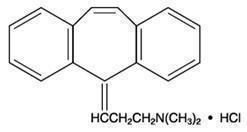CyclobenzaprinePax
Generic name: cyclobenzaprine hydrochloride, capsaicin and menthol patch
Dosage form: kit
Disclaimer: This drug has not been found by FDA to be safe and effective, and this labeling has not been approved by FDA. For further information about unapproved drugs, click here.
On This Page
Cyclobenzaprine Hydrochloride
Cyclobenzaprine Hydrochloride
DESCRIPTION:
Cyclobenzaprine hydrochloride, USP is a white, crystalline tricyclic amine salt with the empirical formula C20H21N•HCl and a molecular weight of 311.9. It has a melting point of 217°C, and a pKa of 8.47 at 25°C. It is freely soluble in water and alcohol, sparingly soluble in isopropanol and insoluble in hydrocarbon solvents. If aqueous solutions are made alkaline, the free base separates. Cyclobenzaprine HCl, USP is designated chemically as 3-(5H-dibenzo[a,d]cyclohepten-5-ylidene)-N, N-dimethyl-1-propanamine hydrochloride, and has the following structural formula:

Cyclobenzaprine hydrochloride, USP is supplied as a 10 mg tablet for oral administration.
Cyclobenzaprine hydrochloride tablets, USP, 10 mg, contain the following inactive ingredients: croscarmellose sodium, D&C Yellow #10 aluminum lake, FD&C Blue #2 aluminum lake, FD&C Yellow #6 aluminum lake, hypromellose, lactose monohydrate, magnesium stearate, microcrystalline cellulose, polyethylene glycol, polyvinyl alcohol, silicon dioxide, talc and titanium dioxide.
CLINICAL PHARMACOLOGY:
Cyclobenzaprine HCl relieves skeletal muscle spasm of local origin without interfering with muscle function. It is ineffective in muscle spasm due to central nervous system disease.
Cyclobenzaprine reduced or abolished skeletal muscle hyperactivity in several animal models. Animal studies indicate that cyclobenzaprine does not act at the neuromuscular junction or directly on skeletal muscle. Such studies show that cyclobenzaprine acts primarily within the central nervous system at brain stem as opposed to spinal cord levels, although its action on the latter may contribute to its overall skeletal muscle relaxant activity. Evidence suggests that the net effect of cyclobenzaprine is a reduction of tonic somatic motor activity, influencing both gamma and alpha motor systems.
Pharmaco



